Whether you’re a commuter, a recreational cyclist, or competing in races and triathlons, you need to make sure you have the right wheels. Here’s how to do it.
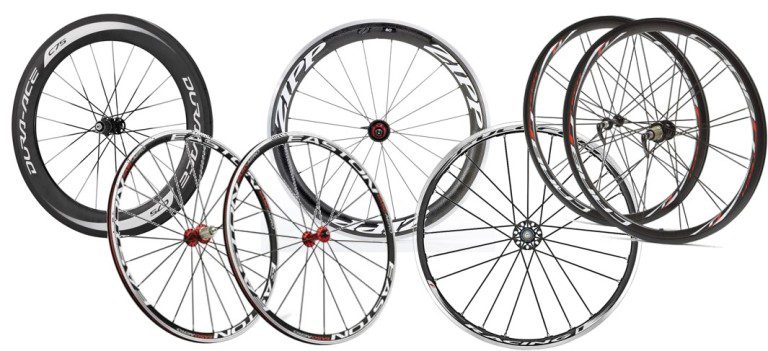
Do you want to transform how your bike feels and handles? Get a new set of wheels.
It can’t be overstated just how important wheels are to the overall feel, handling and comfort when riding. A good set of wheels (ideally shod with a good set of tyres) will make a huge difference to your ride.
The more you pay the better you get. But even entry level wheels these days offer incredible value and performance. Go up the price scale though and you can get all sorts of exotica and engineering in amazingly light weight packages.
Thankfully all road wheels are the same size (700c) and are sold prebuilt and ready to ride. There are a wide variety of manufactures offering many different variations.
Or you can go down the custom route and spec your own rim, hub and spokes and have them built for you.
Drawing up a shortlist
Although all wheels contain three basic component areas (rims, hubs and spokes) the choice available is staggering. It can get overwhelming but it’s not as daunting as it seems.
If you look at each area individually it can help you decide which wheel is best for you and your needs.
Rims
There are several factors to look for when choosing a rim. The depth of a rim dictates a lot of how the wheel will ride. Rims are available in a range of different depths but are split in to three basic categories

Shallow – The traditional box section rim found on most road bikes. They are the cheapest and easiest to produce. They have no aero benefit but tend to be lighter – especially so on expensive wheels.

Mid – A rim depth up to about 30mm is considered a mid section rim. Here there is a slight aero benefit but without as much weight penalty as a deep section rim.
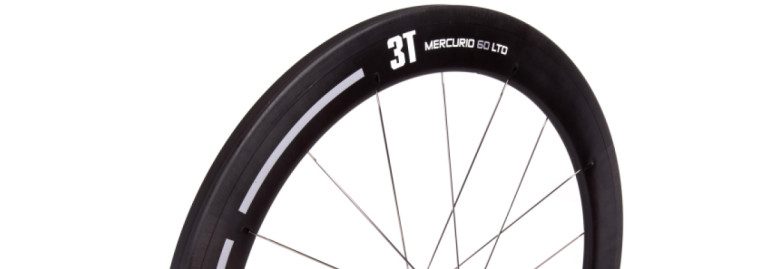
Deep – Rim depth of 40mm and above is considered deep section. These wheels are about slicing through air. They’re great for riding fast. They’re good for most racing as the aerodynamic benefits kick in the faster you ride. They can be heavy though and hard to control in cross winds.
Materials
Carbon – Often the lightest but also the most expensive. They can seem a bit harsh in some circumstances but generally they can offer a better ride quality. It depends how the carbon has been designed to behave.
Alloy – Cheaper but generally heavier for the same size as a carbon rim. Still the most popular material for rim building. Lots of variations available.
Braking surface
The braking surface on the rim can affect how well the brakes work. It’s carbon v alloy again.
Carbon braking surfaces require carbon specific brake blocks as normal blocks will damage the rim and – more importantly – they will not be very powerful.
Alloy braking surfaces are the most popular as they work with any brake block and are cheaper to produce and easier to take care off.
Tubular, clincher or tubeless?
There are three different tyre/rim combinations.
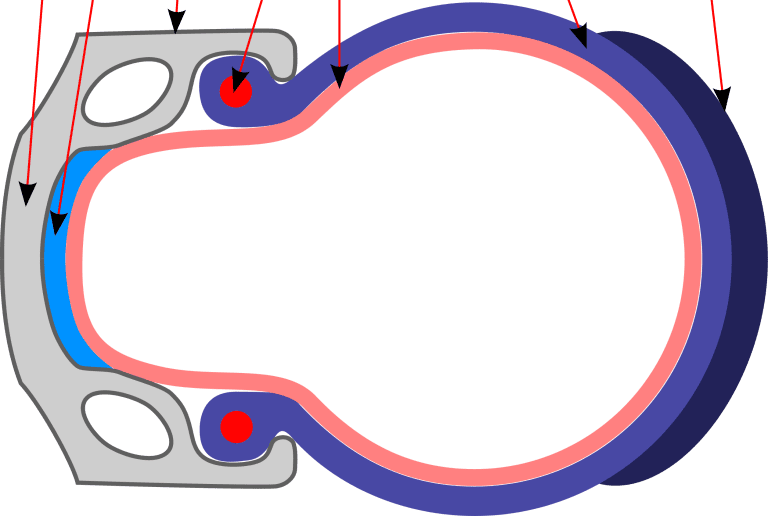
Clincher – Most people’s idea of a normal wheel. The rim has a lip where the bead of the tyre hooks into the rim and a tube is used to inflate the tyre. This is the most popular rim type as it offers the easiest way for riders to change tyres. When you puncture the tube can easily be removed and mended or replaced.
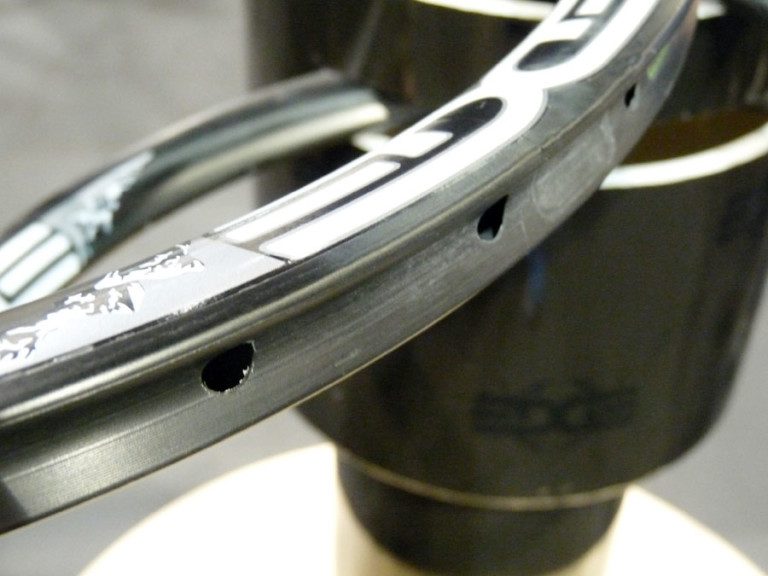
Tubular – AKA tub. The tyre and tube is a one piece construction where the tube is sown into the tyre carcass and glued or taped onto the rim. The rim ends up being lighter as it doesn’t need a lip for the tyre bead to hook into. Tubs also give a better ride feel, especially at higher pressures. They’re also claimed to offer improved rolling resitance. Tubulars can also be run at lower pressures without pinch flats making them ideal for cyclocross racing.
The major drawback is that in the event of a puncture the tubular is very difficult and expensive to repair. Most people just replace them which makes it rather expensive.
Tubeless – The latest innovation. Another technology that has come form mountain bikes. A special clincher type rim and tyre is used but without a tube. The tyre is sealed against the rim with a special leak proof sealant and valve sealer keeps the air in. In the event of a large puncture that the sealant can’t cope with, a tube can still be used.
Rim width
The width of the rim can have an effect on how the tyre performs. The latest trend is for slightly wider rims – we’re talking millimetres here, but still – this allows the tyre to retain its shape especially when cornering under hard loads and means the contact patch is wider thanks to the wider base. In other words the tyre has more side support and doesn’t fold over on itself.
There are also aerodynamic benefits of wider rims (it gets rid of the ‘lightbulb’ tyre profile shape).
Hubs
The main thing to check when buying wheels is the manufacturer compatibility of the hub ie. Shimano/Sram or Campagnolo. The designs aren’t interchangable.
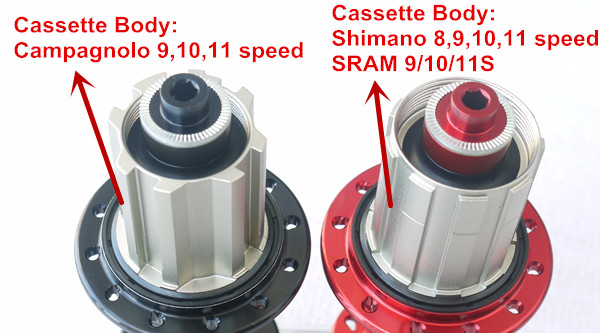
The freehub body (the barrel that the cassette slides on to) will be manufacturer- and speed-specific ie. 10 or 11 speed. So check current gearing and brand before purchase.
Bearings will have a major affect on price and performance of the hub. Steel is the most popular choice but top end hubs have Ceramic bearings which last much, much longer but are very expensive. It’s worth checking to see if the bearings are sealed as servicing may be an issue later on but these days this is less of an issue than it used to be for road wheels.
Checking the availability of replacement freehubs and bearings is a good idea before purchase, especially if you’re spending a lot of money on the wheels.
Spokes
The amount, type and pattern of spokes can have quite an effect on the wheel’s handling.
More spokes are better for strength and load distribution. Ideal for those who give their wheels lots of abuse carrying loads etc. This does make the wheel slightly heavier.

Race wheels tend to have fewer spokes to make them lighter.
Aero spokes cut through the wind better but are more expensive than traditional round spokes.
The way the spokes are assembled into the rim can affect handling. Traditional building crosses the spokes over each other near the hub for added strength, especially on the rear drive side, while some prefer straight pull where the spoke goes straight from hub to rim unimpeded.
Nipples
Spokes are held in place in the rim by nipples. These offer an ideal method of attachment as the spoke is threaded into here rather than fixed into the rim making adjustment and replacement easier.
Nipples are either aluminium or brass. Aluminium are lighter but can corrode if not looked after (road salt eats them). Brass nipples are the hardy traditionalist’s choice but they’re a rare sight on factory made wheels.
It’s also worth checking if the nipples are concealed or exposed as this will determine how easy they are to get to and adjust. If they are concealed then you have to take the rim tape off to get at them but if they are exposed they are much easier to adjust with a spoke key. Make sure you know what you’re doing before you attempt to true your own wheels though as it is a dark art!
Some factory wheels have bespoke nipple designs which require a specific spoke key. Usually this spoke key will be supplied with the wheels. Don’t forget to put it in your saddle pack. Your multi-tool’s spoke key won’t work.
Which road wheels should you buy?
Leisure riders – Weight isn’t such an issue here so any well built tradition box section rim wheel even at entry level will offer good performance for the money without breaking the bank
Regular riders – A slightly lighter wheel will make longer rides more enjoyable. Servicing and longevity are also important. The aero advantages from a medium section rim will be worth considering if you’re a faster rider.
Racers – It’ll depends the course. Most racers will have a couple of sets of wheels, at least. Generally the lighter the better so carbon rims are preferred. For climbing, a stripped down shallow rim is best. For flat drag strip courses a deep section rim will pay dividends at high speeds. Mid section rims are becoming more and more popular as they offer light weight, they aren’t harsh and they’re easier to control in the wind. Ceramic bearings will also reduce drag, marginal gains at its finest, and last a lot longer as well.

Hi
just after some advice, could you please point me in the right direction
looking to change my road bike wheel’s (upgrade) I have a specialised
secteur elite can’t afford a new bike at the moment so looking to improve
components
cheers
Paul
Hi,
Wheels are one of the best upgrades to make if you are looking to improve your ride, a lighter better quality wheel can make a noticeable difference. As a general rule, the more money you spend the lighter the wheel and/or better the bearings, the wheels on your bike are likely to be quite heavy so most of our wheels will be worth your while. It all depends on your budget but one of our popular recommendations are Fulcrums as they are all handmade and we have many satisfied customers using them. They start at under £100 and go up to £749, all our range can be seen here, hope that helps – Thanks http://www.merlincycles.com/factory-road-wheels-44123/?sorting=price_lowHigh
Hi – my hub is worn on my front wheel and Ive been recommended to replace it. do I need to replace both wheels or can I replace just one?
Hi, Its fine to just replace one, Thanks!
Hi guys,
I am considering upgrading the wheels on my roadie (r500 ATM and £250-300 budget). I am a big bloke and don’t want to shell out on new wheels that will constantly break spokes under the strain! Having looked at forums, several people have recommended Campag Zonda wheels, which you stock, which I have noticed have a 3x spoke config. Is this just design novelty or does it have any specific advantages over standard spoke config??
Do you guys have any recommendations?
Thanks in advance
Hi is there a 700c road wheelset you can recommend for a heavy rider?
I’m around 24st and not looking to spend the earth
Tia
Martin
The best choice would be the higher end road cycling gear
. But of course this is very expensive, especially for a beginner. if you can afford it and have a lot of experience on the road then go for it! It will most certainly give you the very best ride cycling can offer! If you have a medium/low budget then check out ebay, you will be able to find some great deals on there.
Pingback: Road Bike Shopping? Our Guide to Doing it Right. - Cyclists.com